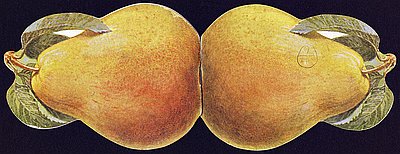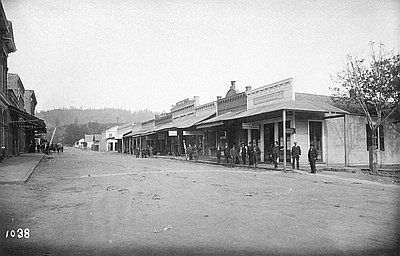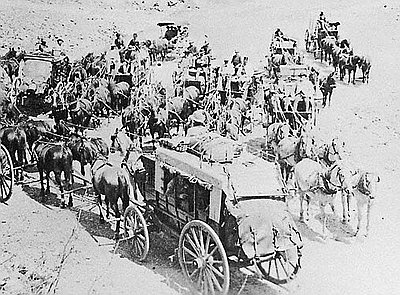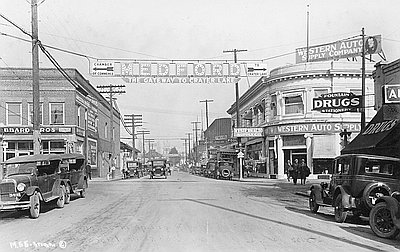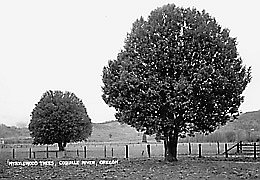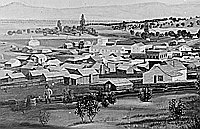Roads, Ranchettes, and Stumps on the Hill
By the late 1960s, societal upheavals—associated in part with the Vietnam War—encouraged individuals to go back to the land, as the saying went. Some people decided to stake out mining claims in the Rogue and Illinois watersheds. As part-time recreational users, they occupied existing cabins or built simple dwellings. They made a few exploration cuts but found insufficient gold to record valid claims. Citing “illegal trespass,” the federal government purchased titles or declared the claims null and void and removed the improvements.
Other people moved to the country and built homes on former farm and forestlands. After 1970, the number of houses in rural locations increased dramatically as developers subdivided large acreages into smaller lots. While some country residents resettled in Grants Pass, Medford, and Ashland, more and more city dwellers settled on ranchettes in the outlying areas. Doublewide mobile homes on five-acre parcels soon dominated the rural landscape.
Improvements to Highways 99, 101, and 199 eased travel difficulties, and many area residents began living in one place and working in another. The completion of Interstate 5 through the Rogue River Valley in 1962 further linked remote rural areas with regional cities. Today, automobile commuters move easily between cities and their homes in outlying areas. Towns such as Jacksonville and Talent increasingly function as bedroom communities and fight the loss of their community identities.
The national demand for lumber after World War II made the timber industry a dominant factor in southwestern Oregon’s economy. To meet market demand, heavy cutting began on private timber holdings, and large lumber companies such as Georgia-Pacific, U.S. Plywood, Weyerhaeuser, and Roseburg Lumber gained control of most cutting and lumber production. As historian Stephen Beckham observed, the ability of these companies to respond to market fluctuations, replant logged areas, bid competitively on federal timber, and afford modernization of their mills gave them a powerful edge in one of the region’s most important industries.
Sawmills proliferated throughout the region, many running two shifts a day. Timber companies hired large numbers of workers to log and haul millions of board feet of Douglas-fir, ponderosa pine, and other trees from public and private lands. The growing pressure to log National Forest timber accelerated road-building in southwestern Oregon’s backcountry.
Extensive road construction and tractor logging soon allowed access to the region’s highest slopes. Between the late 1960s and 1980s, timber companies implemented sustained-yield forestry practices on federal land, which included clearcuts, herbicide treatments, slash burning, and the introduction of conifer plantations. Chain saws, diesel-powered tractors, mobile yarders, and more powerful trucks increased the forests’ yields. Timber companies trucked large log shipments to modern milling facilities in Medford, Grants Pass, and Rogue River for conversion into lumber, plywood, veneer, and other products.
As in the rest of Oregon, the southwestern Oregon timber industry changed markedly in the 1990s following the implementation of multi-agency, long-term, forest planning programs; the placement of the northern spotted owl on the endangered species list; and continued clashes with environmental interests. Massive reduction in the federal timber harvest resulted in slashed income for the counties, and mills closed throughout the region. Since 1980, at least twenty sawmill, veneer, and plywood mills have shut down in Jackson, Josephine, and Curry Counties, resulting in the loss of thousands of jobs.
Environmental issues such as water and air quality, sewage treatment, and the preservation of natural areas came to the forefront as modern logging practices and road construction compromised water resources, vegetation, and fish and wildlife habitat. While modern technology enabled logging companies to harvest timber from remote areas, it also devastated the landscape through clearcuts, herbicide treatment, and slash burning.
Similarly, the reduction in fruit revenues after 1980 sparked sales of orchardland throughout the Rogue River Valley. Longtime fruit growers who had no family members to assume their holdings sold out to large companies or developers. Although many acres remained in production, large tracts of former orchardland eventually supported houses.
Concern about the timber industry’s effect on the environment and the rapid transformation of agricultural lands to subdivisions led some of the region’s inhabitants to look at the ways they use land. Conservation organizations began to monitor timber sales, and land-use decisions and conflict flared over economic and preservation issues.
The region’s natural beauty and livability drew new residents to the area, many of them from California. Faced with rapid population growth, expanding boundaries, and pressure on rural lands for development, community leaders and residents have debated comprehensive plans and zoning, hillside development, and open-space provisions.
Sharply differing opinions on the environment have supported southwestern Oregon’s tendency to reflect statewide patterns of strong urban-rural political regionalism, especially during the last half of the twentieth century. Widely varying attitudes on a number of other issues, including labor, taxation, and religious conservatism in politics divide voters. “Hotly contested political issues, ranging from land-use zoning and timber-harvest levels to controversial social issues” historian Jeffrey LaLande has observed, “periodically have divided the community along class, sectional, and religious lines.”
© Kay Atwood and Dennis J. Gray, 2003. Updated and revised by OHP staff, 2014.
